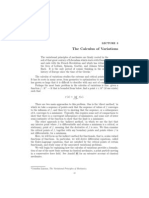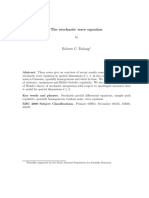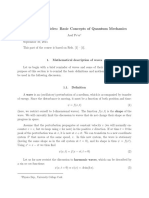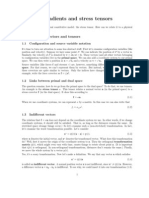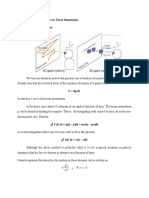Fluid Flow Versus Geometric Dynamics
Fluid Flow Versus Geometric Dynamics
Uploaded by
Dragos IsvoranuCopyright:
Available Formats
Fluid Flow Versus Geometric Dynamics
Fluid Flow Versus Geometric Dynamics
Uploaded by
Dragos IsvoranuOriginal Title
Copyright
Available Formats
Share this document
Did you find this document useful?
Is this content inappropriate?
Copyright:
Available Formats
Fluid Flow Versus Geometric Dynamics
Fluid Flow Versus Geometric Dynamics
Uploaded by
Dragos IsvoranuCopyright:
Available Formats
Fluid ow versus Geometric Dynamics
Dragos Isvoranu and Constantin Udriste
Abstract
This paper investigates the way in which geometric dynamics on Riemannian
manifolds can be applied to uid ow. The equations of motion from uid me-
chanics (momentum equations), expressed on general curvilinear coordinates,
are compared with the equations of motion in a gyroscopic eld of forces. At-
tempts are made to seek conditions under which both describe the same motion,
especially in the case when trajectories are not eld lines. It is proved that all
pathlines and streamlines are geodesics in the least square sense and, in some
circumstances, other trajectories included in geometric dynamics have physical
support.
Mathematics Subject Classication: 37N10, 76B75, 93C15, 34H05, 34B60.
Key words: incompressible ow, Cauchy problem, pathlines, Geometric Dynamics.
1 Deterministic description of uid ow
The basic mathematical point of view of any uid ow is that it can be described by a
point transformation, namely, a family of C
transformations of coordinates indexed
after the time parameter t [1, Aris 1989]. Accepting the idea that we can point out
one individual particle of the ow at a certain moment of time, t = 0, we are able
to dene its initial position as
_
1
,
2
,
3
_
. Later, at the moment t, we will nd the
same particle at position
x = (, t) . (1.1)
The initial coordinates
_
1
,
2
,
3
_
of the particle will be referred as material coordi-
nates and, when convenient, the particle itself may be called particle . Convected
coordinates or Lagrangian coordinates are also used to denote the particle. In the same
coordinate system, the spatial coordinates
_
x
1
, x
2
, x
3
_
can be referred to as particles
position or place. In the case of a deterministic description of a continuous movement
of the particle, it is accepted that the function (1.1) is a bijective application (change
of coordinates). Physically this means that a continuous arc of particles does not
break up during the motion and that, for short time, particles in the neighborhood
The Fifth Conference of Balkan Society of Geometers , August 29 - September 2, 2005, Mangalia-
Romania, pp. 1-1.
c Balkan Society of Geometers, Geometry Balkan Press 2006.
2 Dragos Isvoranu and Constantin Udriste
of a given particle continue to stay in this neighborhood during the motion. Inverting
the function (1.1) we obtain
=
1
(x, t) .
The deterministic character of the motion can be associated to the single valuedness
property of the function x, which means that a particle cannot split up and
cannot occupy two places at the same time nor can two distinct particles occupy the
same place at same instant. Though practically we use derivatives of order one, two
and three, we accept the class C
. Exceptions may be accepted on a nite number of
singular surfaces, lines or points. The necessary and sucient mathematical condition
in order to locally invert the function (1.1) is that the Jacobian satises the condition
J =
Dx
D
,= 0.
The partial function t (, t) may be looked at as the parametric equation of
a curve (particle path or trajectory) in R
3
, having t as parameter. The curve goes
through point at the initial moment t = 0. Any material property of the uid
may be followed along particles path. For example: the density = (, t) in the
neighborhood of a particle ( the density, as seen by an observer riding on the particle,
is a function of time), the position x = (, t) etc. Generally, the material description
of any property can be represented by a function F (, t). It can be changed into a
spatial description f (x, t) via the composition
F (, t) = F
_
1
(, t) , t
_
= f (x, t) . (1.2)
The physical interpretation of relation (1.2) points out that the value of the property
at position x and time t is the value characteristic to the particle that occupies the
position x at time t. The spatial description,
f (x, t) = f ((, t) , t) = F (, t) , (1.3)
means that the value as seen by the particle at time t is the value at the position it
occupies at that time. Associated with these two descriptions there are two derivatives
with respect to time: partial derivative
t
=
_
t
_
x=ct
and material derivative
d
dt
=
_
t
_
=ct
. Thus,
f
t
is the rate of change of property f (x, t) at a xed point x, whereas
dF
dt
is the rate of change of F (, t) as observed when moving with the particle (that
is at constant ). The latter is also known as convected derivative. Hence, the material
velocity of the particle along its path is given by
V (, t) =
_
x
t
_
=ct
=
dx
dt
=
t
=ct
= (, t) = v (x, t) . (1.4)
Combining the previous relation with denition (1.3) allows us to establish a connec-
tion between the material derivative and the spatial derivative
dF
dt
(, t) =
F
t
(, t)
=ct
=
f
t
(x, t)
=ct
=
f
x
i
_
x
i
t
_
=ct
+
f
t
x=ct
(1.5)
Fluid ow versus Geometric Dynamics 3
=
f
x
i
dx
i
dt
+
f
t
x=ct
or
dF
dt
=
f
x
i
i
+
f
t
=
f
t
+ ( ) f =
df
dt
. (1.6)
The spatial velocity eld is dened by v (x, t) = V (, t), where and x are related by
the relation (1.1). The acceleration in the particle coordinate system is
A(, t) =
dV
dt
=
dv
dt
=
v
x
i
i
+
v
t
=
v
t
+ ( ) v. (1.7)
The relation (1.6) points out the connection between the Lagrangian description and
the Eulerian description of the ow. On the other hand, it can be used to write
dv
dt
=
v
t
+ ( ) v, (1.8)
which, along the trajectory, becomes
dv
dt
=
v
t
+ (v ) v since (, t) = v (x, t).
2 Arnolds point of view regarding incompressible
uids
Arnold [3, 1966], [2, 1969] showed that the Euler equations for an incompressible uid
could be given a Lagrangian and Hamiltonian description similar to that of rigid-
body. For ideal uids, the conguration space G (innite dimensional) is the group
Diff
vol
() of volume preserving transformations of the uid control volume (a region
in R
2
or R
3
or a Riemannian manifold in general, possible with boundary). Group
multiplication in G is the composition.
The reason we select G = Diff
vol
() as the conguration space is similar to
that for a rigid body; namely each element of G is a mapping of to that takes
a reference point to a current point x = x() ; thus, knowing x tells us where
each particle of uid goes and hence gives us the uid conguration. We ask that x
be a dieormorphism to exclude discontinuities, cavitation, and uid interpenetra-
tion, and we ask that x be volume preserving to correspond to the assumption of
incompressibility.
A motion of a uid is a family of time-dependent elements of G, which we write
as x = (, t). The material velocity eld is dened by (1.4). If we suppress t in (1.1)
and write for V , we observe that
v =
1
, i.e., v
t
= V
t
1
t
, (2.1)
where
t
() = (, t).
We can regard (2.1) as a map from the space of (, ) (material or Lagrangian
description) to the space of v (x, v) (spatial or Eulerian description). Like the rigid-
body, the material to spatial map (2.2) takes the canonical bracket to a Lie Poisson
bracket; one of our goals is to understand this reduction. Notice that if we replace
by for a xed (time-dependent) Diff
vol
(), then
1
is independent of
; this reects the right invariance of the Eulerian description (v is invariant under
4 Dragos Isvoranu and Constantin Udriste
composition of by on the right). This is also called the particle relabeling symmetry
of uid dynamics). The spaces TG and T
G represent the Lagrangian (material)
description, and we pass to the Eulerian (spatial) description by right translations
and use the (+)Lie-Poisson bracket. One of the things we want to do later is to
better understand the reason for the switch between right and left in going from the
rigid-body to uids.
Dynamics of a Fluid. The Euler equations for an ideal, incompressible, homoge-
neous uid moving in the region are
v
t
+ (v ) v =
p
, (2.2)
with the constraint div v = 0 and the boundary condition that the velocity vector
eld v is tangent to the boundary .
The pressure p is determined implicitly by the divergence-free (volume - preserv-
ing) constraint (see [7, Chorin and Marsden 2000 ] for basic information on the deriva-
tion of Eulers equations). The associated Lie algebra g is the space of all solenoidal
(divergence-free) vector elds tangent to the boundary. This Lie algebra is endowed
with the negative Jacobi-Lie bracket of vector elds given by
[v, w]
i
L
=
n
j=1
_
w
j
v
i
x
j
v
j
w
i
x
j
_
.
The subscript L on the bracket refers to the fact that it is the left Lie algebra bracket
on g. The most common convention for the Jacobi-Lie bracket of vector elds, also
the one we adopt, has the opposite sign. Also we identify g and g
using the pairing
v, w) =
_
v.wd
3
x.
Hamiltonian Structure. We introduce the (+)Lie-Poisson bracket, called the ideal
uid bracket, on functions of velocity v by
F, G (v) =
_
v.
_
F
v
,
G
v
_
L
d
3
x,
where
F
v
is dened by
lim
0
1
[F (v +v) F (v)] =
_
v.
F
v
d
3
x.
With the energy function chosen to be the kinetic energy
H (v) =
1
2
_
|v|
2
d
3
x,
one can verify that the Euler equations (2.2) are equivalent to the Poisson bracket
equations
F = F, H ,
Fluid ow versus Geometric Dynamics 5
for all functions F on g. To see this, it is convenient to use the orthogonal decom-
position w = Pw + p of a vector eld w into a divergence-free part Pw in g and a
gradient. Then the Euler equations can be written
v
t
+P (v.v) = 0.
One can express the Hamiltonian structure in terms of the velocity as a basic dynamic
variable and show that the preservation of coadjoint orbits amounts to Kelvins circu-
lation theorem. Marsden and Weinstein [13, 1983] show that the Hamiltonian struc-
ture in terms of Clebsch potentials ts naturally into this Lie-Poisson scheme, and
that Kirchhos Hamiltonian description of point vortex dynamics, vortex laments,
and vortex patches can be derived in a natural way from the Hamiltonian structure
described above.
Lagrangian Structure. The general framework of the Euler-Poincare and the Lie-
Poisson equations gives other insights as well. For example, this general theory shows
that the Euler equations are derivable from the variational principle
_
b
a
_
1
2
|v|
2
d
3
x = 0,
which is to hold for all variations v of the form v = u + [v, u]
L
(sometimes called
Lin constraints, [5]), where u is a vector eld (representing the innitesimal displace-
ment of the particle) vanishing at the temporal endpoints (this Lagrange-dAlembert
principle is due to Newcomb.
There are important functional-analitic dierences between working in material
representation (that is, on T
G) and in Eulerian representation (that is, on g
) that
are important for proving existence and uniqueness theorems, theorems on the limit of
zero viscosity, and the convergence of numerical algorithms (see [9, Ebin and Marsden
1970], [6, Chorin, Hughes, Marsden, and McCracken 1978]). Finally, we note that for
two-dimensional ows, a collection of Casimir functions is given by
C () =
_
( (x)) d
2
x, (2.3)
for : R R, any smooth function and k = v, the vorticity. For three
dimensional ows the function (2.3) is no longer a Casimir function.
3 Pathlines and streamlines in uid dynamics
Suppose X (x, t) is a given velocity eld for a specic uid ow in a domain of R
2
or R
3
. First we need to select the evolution parameter and to introduce the evolution
ODE. Second, we need the initial position of the particle, leading us to a Cauchy
problem. From the point of view of uid mechanics, two situations are to consider
regarding kinematics of a material particle: pathline and streamline.
Pathlines are solutions of the Cauchy problems
dx
dt
= X (x(t) , t) , x(0) = x
0
6 Dragos Isvoranu and Constantin Udriste
and streamlines are solutions of dierent Cauchy problems
dx
ds
= X (x(s) , t) , x(0) = x
0
. (3.1)
In the second case, s is the parameter along the streamline, dierent from time para-
meter t which is held constant while the equations (3.1) are integrated. The parameter
t can produce bifurcation in the equilibrium set or Hopf bifurcation of the ow. When
the eld X is autonomous, the pathlines coincide with streamlines.
4 Geometric dynamics derived from a velocity eld
in Riemannian space
Suppose X (x, t) is a given contravariant vector eld on a Riemannian manifold (M, g),
depending on the time parameter t, and
dx
dt
= X (x(t) , t) (4.1)
is the associated rst order nonautonomous dierential system (pathlines). In order
to obtain the prolongation by derivation of the system (4.1), we only have to take
the temporal derivative (along a solution) of both members. The derivative of the
left-hand side yields the contravariant components of the acceleration of the system
A
i
=
d x
i
dt
+
i
jk
x
k
x
j
, (4.2)
where
i
jk
are the second order Christoel symbols produced by the Riemannian
metric g. The covariant dierentiation of the right-hand side of 4.1 reads
X
i
t
=
X
i
t
+X
i
,j
dx
j
dt
=
X
i
t
+
_
X
i
x
j
+
i
jk
X
k
_
dx
j
dt
If we add and substract the Riemannian adjoint tensor g
ih
g
kj
X
k
,h
of X
i
,j
in the previous
relations, we obtain
X
i
t
=
X
i
t
+
_
X
i
,j
g
ih
g
kj
X
k
,h
_
dx
j
dt
+g
ih
g
kj
X
k
,h
dx
j
dt
. (4.3)
The skew-symmetric (with respect to the Riemannian metric) coecient
F
i
j
= X
i
,j
g
ih
g
kj
X
k
,h
is an external tensor that characterizes the helicity of the vector eld X. If we replace
in the last term of (4.3), the derivative of the position vector by the corresponding
velocity eld component and the left-hand side with the acceleration given by (4.2),
we obtain the prolongation specic to geometric dynamics formalism ([16, Udriste
2000a]- [24, waf2005])
x
i
+
i
jk
x
k
x
j
=
X
i
t
+F
i
j
x
j
+g
ih
g
kj
X
k
,h
X
j
. (4.4)
Fluid ow versus Geometric Dynamics 7
The second order ODE (4.4) represents an Euler-Lagrange prolongation of rst order
ODE (4.1), containing three force elds: one gyroscopic eld of forces, represented by
F
i
j
x
j
, one conservative eld of forces
g
ih
f
x
h
= g
ih
g
kj
X
k
,h
X
j
, (4.5)
and nally, the eld of temporal variation
X
i
t
. The function f =
1
2
g (X, X) is the
potential energy density associated with X and with Riemannian structure g. The
Lagrangian L producing (4.4) as Euler-Lagrange equations, i.e.,
L
x
d
dt
L
x
= 0,
is given by
L =
1
2
g ( x X, x X) ,
i.e., it is a least squares Lagrangian. The equations (4.4) show that the eld lines (4.1)
are geodesics in a suitable structure, and that the set of all such geodesics is larger
than the set of pathlines.
The Cauchy problem in the case of geometric dynamics equations, brings out two
situations. One case is illustrated by conditions of type
x(0) = x
0
,
dx
dt
t=0
= X (x(0) , 0) ,
that will describe nothing else but a pathline. The second, is a totally dierent situ-
ation,
x(0) = x
0
,
dx
dt
t=0
= Y (x(0) , 0) , (4.6)
where Y represents some arbitrary initial conditions dierent from the values of the
velocity eld X, at rst instant. We call this situation an injection with respect to
the ow generated by X.
Now, let us change the previous point of view starting with the system which
describes the streamlines,
dx
ds
= X (x(s) , t) .
In this sense the evolution parameter s is dierent from the time parameter t. We can
repeat the previous ideas to produce a geometric dynamics with evolution parameter
s, but with forces depending on the time-parameter t.
5 Dynamics derived from a force eld in Riemannian
space
The purpose of dynamics is to assess the motion of a system under the inuence of
forces acting on it. Ingredients:
8 Dragos Isvoranu and Constantin Udriste
x = position, t = time, v = velocity, a = acceleration,
m = mass, F = force eld, = vector eld parameter
The trajectories of the system are generated by solving the second order dierential
system of equations,
a =
F
m
= X,
once the force eld F (x, t) or F (x, v, t) or F (x, v, , t) is known. In the general case
we have F (x(t) , v (x, t) , (x, t) , t).
Following this idea, we can imagine that the force eld comes from a generalized
potential U = U (x(t) , x(t) , t). In this case, the Lagrangian has the following general
form
L(t, x(t) , x(t)) =
1
2
m| x(t)|
2
U (x(t) , x(t) , t) .
Apart from Euler-Lagrange equations, the Hamilton principle regarding the station-
arity of the action functional, yields the denition of the functional derivative
f
of
any scalar eld ([11, Gottlieb et. al. 1997])
f
x
i
=
x
i
d
dt
_
x
i
_
.
Consequently, the Euler-Lagrange equations can be written
f
L
f
x
i
= 0 and the force
eld is dened by
f
U/
f
x = F. This denition produces the covariant components
F
i
(t, x(t) , x(t)) =
U
x
i
+
d
dt
_
U
x
i
_
.
Thus, the covariant components of the force eld are
F
i
(t, x(t) , x(t)) =
U
x
i
+
2
U
t x
i
+ x
k
2
U
x
k
x
i
+ x
k
2
U
x
k
x
i
.
The natural hypothesis that F does not depend on the acceleration x(t) is equivalent
to
2
U
x
k
x
i
= 0, i.e., U (t, x(t) , x(t)) = W (t, x(t)) + x
i
A
i
(t, x(t)) and hence
F
i
=
W
x
i
+
A
i
t
+ x
k
_
A
i
x
k
A
k
x
i
_
.
Here W is the so called simple potential and A is the potential vector associated
with W. The components of the force eld generated by the generalized potential U
contains a conservative part, a temporal variation of the potential vector eld and a
gyroscopic force eld, similar to force eld generated by the velocity eld (4.4)-(4.5).
The previous explanations shows that the Euler-Lagrange equations
f
L
f
x
i
= 0
dier from those in geometric dynamics generated by the vector eld (ow) A only
by gradient terms.
Fluid ow versus Geometric Dynamics 9
6 Leap from uid ow to geometric dynamics
Let us consider an alternative to (1.8), the so called Helmholtz representation of uid
ow ([10, Florea and Panaitescu 1979])
v
t
+
_
v v
2
_
+ ( v) v = f
p
, (6.1)
where v (x, t) is the velocity eld, p is the pressure eld, f an external force eld and
is the constant eld of density. Usually, equation (6.1) represents the main tool in
nding the velocity eld in a given domain in R
2
or R
3
. The left hand side of it
comprises the acceleration eld composed by a local eld v/t and the transport or
convective eld, the remaining two terms. Simple vector algebra shows that (v ) v
from (1.8) transforms accordingly in the convective part of the acceleration eld, such
that
dv
dt
=
v
t
+ (v ) v =
v
t
+
_
v v
2
_
+ ( v) v, (6.2)
represents nothing but a series of identities. We would like to transform the identity
(6.2) in a dierential equation expressing a dynamic. Taking into account the way
vector operators gradient and curl act, the only possibility resides in replacing the
material property velocity, in Lagrange representation, v = x, as follows
d x
dt
=
v
t
+
_
v v
2
_
+ ( v) x. (6.3)
Relation (6.3) is the equivalent of geometric dynamics (4.4) if we identify the con-
travariant components of the acceleration on a Riemannian manifold, d x/dt, with the
left hand side of (4.4),
d x
i
dt
= x
i
+
i
jk
x
k
x
j
.
The contravariant components of the gradient are
_
v v
2
_
:
1
2
g
ij
_
g
lm
v
l
v
m
_
,j
= g
ij
g
lm
v
l
,j
v
m
similar to the last term of (4.4). The outer product of the curl of the velocity eld
and x can be written in tensorial notation as
( v) x :
ijk
_
jlm
g
lp
v
p
,m
_
x
k
=
_
l
k
m
i
l
i
m
k
_
g
lp
v
p
,m
x
k
,
or more
( v) x :
_
l
k
m
i
l
i
m
k
_
g
lp
v
p
,m
x
k
=
_
g
kp
v
p
,i
g
ip
v
p
,k
_
x
k
.
Its contravariant components are expressed as
( v) x : g
jk
_
g
kp
v
p
,i
g
ip
v
p
,k
_
x
k
=
_
v
j
,i
g
jk
g
ip
v
p
,k
_
x
k
.
One can easily identify the last expression with the gyroscopic force F
i
j
x
j
, with F
i
j
given by (4.5) and X
j
= v
j
. If we reassamble equation (6.2) by contravariant compo-
nents we get the equations of geometric dynamics
10 Dragos Isvoranu and Constantin Udriste
x
i
+
i
jk
x
k
x
j
=
v
i
t
+F
i
j
x
j
+g
ih
g
kj
v
k
,h
v
j
.
We conclude that solutions of (6.3) are geodesics in the least-square sense as described
in 3.
7 Comparison between discrete-phase model and
geometric dynamics
The solution of (4.4) with initial conditions (4.6) is a trajectory that is not a pathline.
We wonder if this situation may have any physical support. One possible answer lies in
analyzing a discrete-phase ow, meaning the injection of a dierent material particle
at some xed point in the basic ow-eld. The physics of discrete-phase ow represents
one of the most challenging issues for scientists. The deterministic approach of this
type of ows takes into account the interaction between the basic uid ow and the
discrete-phase through several forces like drag, virtual mass, Bassett or external forces
([12, Kuan 1986]). In this case, the particle follows deterministic trajectory found via
the velocity v
p
of the particle along its path which is a solution of the Lagrangian
equations of motion
dv
p
dt
= C
D
p
[v v
p
[ (v v
p
) +
1
2
p
d (v v
p
)
dt
p
p
+f
B
+f
c
, (7.1)
where v is the velocity of basic ow, C
D
is the drag coecient, the density of the
uid,
p
the density of the particle injected, p pressure, f
B
is the volumic Bassett
force accounting for the deviation of the ow from the steady ow pattern around
a sphere. Its particular expression may be found in [12, Kuan 1986] and f
c
other
volumic external forces e.g., gravity. In the case of a perfect uid and for negligible
diameter of the particle, the drag coecient vanishes, likewise Bassett force and other
external forces, such that (7.1) becomes
dv
p
dt
=
1
2
p
d (v v
p
)
dt
p
p
. (7.2)
Assuming the knowledge of basic ow and that its pattern in the neighborhood of the
discrete-phase injected is not aected by this injection, it is much simpler to solve
the motion of the injected particle following the geometric dynamics equations rather
than (7.2).
8 Application of Udriste dynamics to the potential
ow around a circle
In this case the Cartesian components of the velocity eld are
dx
dt
= u = U
_
1 a
2
x
2
y
2
(x
2
+y
2
)
2
_
,
dy
dt
= v = 2U
a
2
xy
(x
2
+y
2
)
2
,
Fluid ow versus Geometric Dynamics 11
where a is the circle radius. The equations of Udriste geometric dynamics ([15], [16])
are
d
2
x
dt
2
= U
2
a
2
x
_
x
2
+a
2
+ 3y
2
_
(x
2
+y
2
)
4
,
d
2
y
dt
2
= U
2
a
2
y
_
3x
2
+a
2
+y
2
_
(x
2
+y
2
)
4
. (8.1)
Considering a = 0.2m and U
= 1m/s let us approximate the trajectories for the
following initial conditions:
a) x
0
= 0.5m, y
0
= 0.1m, u
0
= 0.858m/s, v
0
= 0.0591m/s, streamline
b) x
0
= 0.5m, y
0
= 0.1m, u
0
= 0.858m/s, v
0
= 0.0m/s, injection
c) x
0
= 0.5m, y
0
= 0.1m, u
0
= 0.858m/s, v
0
= 0.0591m/s, injection
d) x
0
= 0.5m, y
0
= 0.1m, u
0
= 0.5m/s, v
0
= 0.0591m/s, injection
e) x
0
= 0.5m, y
0
= 0.1m, u
0
= 0.1m/s, v
0
= 0.0591m/s, injection
f ) x
0
= 0.5m, y
0
= 0.1m, u
0
= 0.0m/s, v
0
= 0.0m/s, injection
g) x
0
= 0.5m, y
0
= 0.1m, u
0
= 0.84m/s, v
0
= 0.0m/s, streamline at stagnation
point
h) x
0
= 0.193m, y
0
= 0.051m, u
0
= 0.134m/s, v
0
= 0.5m/s, streamline on the
circle
The results of the numerical integration of (8.1) are given in gures 1, 2 and 3.
Fig. 1. Fig. 2. Fig. 3.
9 Conclusions
We have investigated the basic equations of uid ow and proved that streamlines
and, in some cases, pathlines are the solutions of the equations of geometric dynamics.
Work has further to be done when considering the interaction between the basic ow
eld and particles own ow pattern.
12 Dragos Isvoranu and Constantin Udriste
References
[1] R. Aris, R., Vectors, Tensors and the Basic Equations of Fluid Flow, Dover Publ.
Inc., New York, 1989.
[2] V.I. Arnold, Caracterul hamiltonian al ecuatiilor lui Euler ale dinamicii solidului
rigid si uidului ideal, Uspehi Matem. Nauk., XXIV, 3 , 147 (1969), 225-246.
[3] V.I. Arnold, Sur la geometrie dierentielle des groupes de Lie de dimension
innie et ses applications a lhydrodynamique des uids parfaits, Annales de
LInstitut Fourier, XVI, 1 (1966), 319-361.
[4] M.T. Calapso, C. Udriste, Tzitzeica and Walras Laws in Geometric Economics,
Analele Universitatii Bucuresti, 55, 1 (2005), 213-218.
[5] H. Cendra, J. Marsden, Lin constraints, Clebsch potentials and variational prin-
ciples, Physica D: Nonlinear Phenomena 27, 1-2 (1987), 63-89.
[6] A.J. Chorin, T.J.R. Hughes, M.J. McCracken, J.E. Marsden, Product formulas
and numerical algorithms, Comm. Pure. Appl. Math., 31 (1978), 205-256.
[7] A.J. Chorin, J.E. Marsden, A Mathematical Introduction to Fluid Mechanics,
Springer-Verlag, New York, 2000.
[8] I. Duca, A. M. Teleman, C. Udriste, Poisson-gradient dynamical systems with
convex potential, Proceedings of The 3-rd International Colloquium Mathe-
matics in Engineering and Numerical Physics, October 7-9, 2004, University
Politehnica of Bucharest, BSG Proceedings 12, Geometry Balkan Press (2005),
128-136.
[9] D. Ebin, J.E. Marsden, Groups of dieomorphisms and the motion of an incom-
pressible uid, Ann. of Math., 92 (1970), 102-163.
[10] J. Florea, V. Panaitescu, Mecanica uidelor, Ed. Did. si Ped., Bucuresti, 1979.
[11] I. Gottlieb, C. Dariescu, M.A. Dariescu, Fundamentarea mecanicii cuantice, Ed.
Tehnica Chisinau, 1997.
[12] K. Kuan-yun Kuo, Principles of Combustion, John Willey, 1986.
[13] J.E. Marsden, A., Weinstein, Coadjoint orbits, vortices and Clebsch variables for
incompressible uids, Physica, 7D (1983), 305-323.
[14] C. Udriste, Geodesic motion in a gyroscopic eld of forces, Tensor, N. S., 66, 3
(2005), 215-228.
[15] C. Udriste, Geometric Dynamics, Kluwer Academic Publishers, 2000.
[16] C. Udriste, Geometric Dynamics, Southeast Asian Bulletin of Mathematics,
Springer-Verlag, 24 (2000), 313-322.
[17] C. Udriste, Tools of Geometric Dynamics, Buletinul Institutului de Geodinamica,
Academia Romana, 14, 4 (2003), 1-26.
Fluid ow versus Geometric Dynamics 13
[18] C. Udriste, A. Ciancio, Linearized Geometric Dynamics of Tobin-Benhabib-
Miyao economic ow, Balkan Journal of Geometry and Its Applications, 9, 1
(2004), 125-130.
[19] C. Udriste, I. Duca, Periodical solutions of multi-time Hamilton equations,
Analele Universitatii Bucuresti, 55, 1 (2005), 179-188.
[20] C. Udriste, M. Ferrara, D. Opris, Economic Geometric Dynamics, Geometry
Balkan Press, 2004.
[21] C. Udriste, M. Postolache Atlas of Magnetic Geometric Dynamics, Geometry
Balkan Press, Bucharest, 2001.
[22] C. Udriste, A.M. Teleman, Hamiltonian approaches of Field Theory, IJMMS, 57
(2004), 3045-3056.
[23] C. Udriste, S. Udriste, Queue Geometric Dynamics, Proceedings of 2005 Annual
Hawaii International Conference on Statistics, Mathematics and Related Fields,
January 9-11 2005, Honolulu, Hawaii (electronic version).
[24] C. Wafo Soh, C. Udriste, Symmetries of second order potential dierential sys-
tems, Balkan Journal of Geometry and Its Applications, 10, 2 (2005), 129-141.
Authors addresses:
Dragos Isvoranu and Constantin Udriste
Dept. of Thermodynamics and Dept. of Mathematics,
University Politehnica of Bucharest,
Splaiul Independentei 313, RO-060042, Bucharest, Romania. email: dragos@aero.pub.ro
and udriste@mathem.pub.ro
You might also like
- Class 12 Physics Derivations Shobhit Nirwan PDFDocument48 pagesClass 12 Physics Derivations Shobhit Nirwan PDFMRIDUL VYAS94% (81)
- A New Understanding of Particles by G - Flow Interpretation of Differential EquationDocument10 pagesA New Understanding of Particles by G - Flow Interpretation of Differential EquationDon HassNo ratings yet
- Chapter 4 - The Kinematics of Fluid Motion: T X X TDocument15 pagesChapter 4 - The Kinematics of Fluid Motion: T X X THengNo ratings yet
- A. H. Taub - Relativistic Fluid MechanicsDocument33 pagesA. H. Taub - Relativistic Fluid MechanicsJuaxmawNo ratings yet
- Artigo FKDVDocument8 pagesArtigo FKDVRoberto JuniorNo ratings yet
- The Calculus of VariationsDocument52 pagesThe Calculus of VariationsKim HsiehNo ratings yet
- Itzhak Bars and Moises Picon - Twistor Transform in D Dimensions and A Unifying Role For TwistorsDocument34 pagesItzhak Bars and Moises Picon - Twistor Transform in D Dimensions and A Unifying Role For TwistorsGum0000No ratings yet
- Chap04 PDFDocument51 pagesChap04 PDFIpsita MandalNo ratings yet
- Fluids 1Document20 pagesFluids 1yves.pardavellNo ratings yet
- NLA Edit Draft (Jan26)Document28 pagesNLA Edit Draft (Jan26)Justin WebsterNo ratings yet
- Basic Fluid Dynamics: Yue-Kin Tsang February 9, 2011Document12 pagesBasic Fluid Dynamics: Yue-Kin Tsang February 9, 2011alulatekNo ratings yet
- Deformation, Stress, and Conservation Laws: I U U XDocument31 pagesDeformation, Stress, and Conservation Laws: I U U XFelipe Carrasco DuránNo ratings yet
- Chapter 1Document13 pagesChapter 1Jmartin FloresNo ratings yet
- Dalang SLCDocument33 pagesDalang SLCal631moNo ratings yet
- 2 Wave Equations and Their SolutionDocument11 pages2 Wave Equations and Their SolutionPanagiotis StamatisNo ratings yet
- Chapter One: Fundamental Concept of TensorsDocument47 pagesChapter One: Fundamental Concept of Tensorsmoon_moz8069No ratings yet
- Calculus of Variations: Generalized Solutions of A Kinetic Granular Media Equation by A Gradient Flow ApproachDocument26 pagesCalculus of Variations: Generalized Solutions of A Kinetic Granular Media Equation by A Gradient Flow Approachjorge rodriguezNo ratings yet
- Gravity and Gauge Theory: Thanks To Arthur Fine, Chris Isham, and Bob Wald For Helpful DiscussionsDocument10 pagesGravity and Gauge Theory: Thanks To Arthur Fine, Chris Isham, and Bob Wald For Helpful DiscussionsΜιλτος ΘεοδοσιουNo ratings yet
- Propagation of Love Waves in An Elastic Layer With Void PoresDocument9 pagesPropagation of Love Waves in An Elastic Layer With Void Poresmadhumitakundu1976No ratings yet
- Chapter 1Document30 pagesChapter 1Abdullahi DaudNo ratings yet
- On Classical Dynamics of Af F Inely-Rigid Bodies Subject To The Kirchhof F-Love ConstraintsDocument12 pagesOn Classical Dynamics of Af F Inely-Rigid Bodies Subject To The Kirchhof F-Love ConstraintsBayer MitrovicNo ratings yet
- ME 563 - Intermediate Fluid Dynamics - Su: Lecture 28 - Waves: The BasicsDocument3 pagesME 563 - Intermediate Fluid Dynamics - Su: Lecture 28 - Waves: The Basicszcap excelNo ratings yet
- KinematicsDocument17 pagesKinematicsDiogo CecinNo ratings yet
- Introduction. Configuration Space. Equations of Motion. Velocity Phase SpaceDocument11 pagesIntroduction. Configuration Space. Equations of Motion. Velocity Phase SpaceArjun Kumar SinghNo ratings yet
- Fluidsnotes PDFDocument81 pagesFluidsnotes PDFMohammad irfanNo ratings yet
- Equation of Fluid MotionDocument7 pagesEquation of Fluid MotionMohammedRafficNo ratings yet
- GFDL Barotropic Vorticity EqnsDocument12 pagesGFDL Barotropic Vorticity Eqnstoura8No ratings yet
- Lecture Notes On Cosmology (ns-tp430m) by Tomislav Prokopec Part I: An Introduction To The Einstein Theory of GravitationDocument37 pagesLecture Notes On Cosmology (ns-tp430m) by Tomislav Prokopec Part I: An Introduction To The Einstein Theory of GravitationEnzo SoLis GonzalezNo ratings yet
- Waves and Particles: Basic Concepts of Quantum Mechanics: Physics Dep., University College CorkDocument33 pagesWaves and Particles: Basic Concepts of Quantum Mechanics: Physics Dep., University College Corkjainam sharmaNo ratings yet
- 1 Transverse Vibration of A Taut String: X+DX XDocument22 pages1 Transverse Vibration of A Taut String: X+DX XwenceslaoflorezNo ratings yet
- Contraction PDFDocument27 pagesContraction PDFMauriNo ratings yet
- Ggerv CcccccsDocument28 pagesGgerv CcccccsAnonymous BrUMhCjbiBNo ratings yet
- Dynamic Equilibrium of Deformable Solids 2021 PDFDocument25 pagesDynamic Equilibrium of Deformable Solids 2021 PDFAbdolreza AghajanpourNo ratings yet
- I. Development of The Virial TheoremDocument14 pagesI. Development of The Virial Theoremjohnsmith37758No ratings yet
- Notes PDFDocument59 pagesNotes PDFnajera_No ratings yet
- Relativity v1.2Document13 pagesRelativity v1.2hassaedi5263No ratings yet
- Levinson Elasticity Plates Paper - IsotropicDocument9 pagesLevinson Elasticity Plates Paper - IsotropicDeepaRavalNo ratings yet
- 3.1 Flow of Invisid and Homogeneous Fluids: Chapter 3. High-Speed FlowsDocument5 pages3.1 Flow of Invisid and Homogeneous Fluids: Chapter 3. High-Speed FlowspaivensolidsnakeNo ratings yet
- The Stochastic Wave Equation: Summary. These Notes Give An Overview of Recent Results Concerning The Non-LinearDocument2 pagesThe Stochastic Wave Equation: Summary. These Notes Give An Overview of Recent Results Concerning The Non-Linearfbensaber1No ratings yet
- D. Iftimie Et Al - On The Large Time Behavior of Two-Dimensional Vortex DynamicsDocument10 pagesD. Iftimie Et Al - On The Large Time Behavior of Two-Dimensional Vortex DynamicsJuaxmawNo ratings yet
- Derivation of Plank Einstain ConstantDocument7 pagesDerivation of Plank Einstain ConstantVidyesh KrishnanNo ratings yet
- Wave EqnDocument15 pagesWave EqnALNo ratings yet
- Lecture5.Mean Free Path and Transport PhenomenaDocument12 pagesLecture5.Mean Free Path and Transport PhenomenaKacper SamulNo ratings yet
- Loss of Energy Concentration in Nonlinear Evolution Beam Equations (Journal of Nonlinear Science) (2017)Document39 pagesLoss of Energy Concentration in Nonlinear Evolution Beam Equations (Journal of Nonlinear Science) (2017)rxflexNo ratings yet
- Genesis and Progress of Virtual Power Principle: OriginalpaperDocument15 pagesGenesis and Progress of Virtual Power Principle: OriginalpapermustaphaNo ratings yet
- A Note On Particle Kinematics in Ho Rava-Lifshitz ScenariosDocument8 pagesA Note On Particle Kinematics in Ho Rava-Lifshitz ScenariosAlexandros KouretsisNo ratings yet
- Velocity Gradients and StressTensorsDocument4 pagesVelocity Gradients and StressTensorskenanoNo ratings yet
- Heinzle. Introduction To Relaivity and Cosmology PDFDocument224 pagesHeinzle. Introduction To Relaivity and Cosmology PDFDavid PrietoNo ratings yet
- Wiggly Relativistic Strings: UFIFT-HEP-92-10 Hep-Ph/9210210Document10 pagesWiggly Relativistic Strings: UFIFT-HEP-92-10 Hep-Ph/9210210BattleAppleNo ratings yet
- 6.7 Introduction Dynamics in Three Dimensions A. General PrinciplesDocument12 pages6.7 Introduction Dynamics in Three Dimensions A. General PrincipleselvyNo ratings yet
- 3 1 IrrotDocument4 pages3 1 IrrotShridhar MathadNo ratings yet
- Fluid Mechanics IIIDocument93 pagesFluid Mechanics IIIRanjeet Singh0% (1)
- Daniel Spirn and J. Douglas Wright - Linear Dispersive Decay Estimates For Vortex Sheets With Surface TensionDocument27 pagesDaniel Spirn and J. Douglas Wright - Linear Dispersive Decay Estimates For Vortex Sheets With Surface TensionPonmijNo ratings yet
- Lecture 5Document7 pagesLecture 5sivamadhaviyamNo ratings yet
- Hydrodynamics in Two Dimensions and Vortex Theory : PhysicsDocument22 pagesHydrodynamics in Two Dimensions and Vortex Theory : Physicsyijat18183No ratings yet
- Overview of Classical Mechanics: 1 Ideas of Space and TimeDocument7 pagesOverview of Classical Mechanics: 1 Ideas of Space and TimeredcoatNo ratings yet
- April 27, 2006 10:13 Book Trim Size For 9in X 6in FieldDocument10 pagesApril 27, 2006 10:13 Book Trim Size For 9in X 6in FieldShridhar MathadNo ratings yet
- Notes Wave Solitons-L5 Ajit-1Document30 pagesNotes Wave Solitons-L5 Ajit-1Mr FeynmanNo ratings yet
- General Principles of Brane Kinematics and DynamicsDocument12 pagesGeneral Principles of Brane Kinematics and DynamicsOliver BardinNo ratings yet
- Molecular Orbital Theory (MOT) : Student Worksheet of Physical Chemistry I: Chemical Structure & BondingDocument5 pagesMolecular Orbital Theory (MOT) : Student Worksheet of Physical Chemistry I: Chemical Structure & BondingNikke ArdilahNo ratings yet
- Functions of Several Variables: MATH1251 - Calculus OutlineDocument11 pagesFunctions of Several Variables: MATH1251 - Calculus OutlineVladmirNo ratings yet
- Wiess Mean Field Theory of Magnetism 1Document22 pagesWiess Mean Field Theory of Magnetism 1DEEPAK VIJAYNo ratings yet
- Analysis of Additional Mathematics SPM PapersDocument2 pagesAnalysis of Additional Mathematics SPM PapersJeremy LingNo ratings yet
- What Is The Electron Spin?: by Gengyun LiDocument91 pagesWhat Is The Electron Spin?: by Gengyun LiSiva Krishna100% (1)
- Lesson 2 Vector SpacesDocument15 pagesLesson 2 Vector SpacesGauthier ToudjeuNo ratings yet
- 1 AwaaDocument17 pages1 AwaaniorecruhjNo ratings yet
- Hartree-Fock On A Superconducting Qubit Quantum ComputerDocument30 pagesHartree-Fock On A Superconducting Qubit Quantum ComputerLETSOGILENo ratings yet
- Coriolis and Centrifugal ForcesDocument6 pagesCoriolis and Centrifugal ForcesDavid YoDa Tecuanhuehue PaulinoNo ratings yet
- LorentzDocument20 pagesLorentzDaniel Ortiz CampaNo ratings yet
- Physical Work 3Document25 pagesPhysical Work 3ScribdTranslationsNo ratings yet
- ATM-3 - The 2nd Law of ThermodynamicsDocument39 pagesATM-3 - The 2nd Law of Thermodynamics廖奕翔No ratings yet
- Entropy in Statistical Mechanics. - Thermodynamic ContactsDocument25 pagesEntropy in Statistical Mechanics. - Thermodynamic ContactssridharbkpNo ratings yet
- ME203Document2 pagesME203Lionel MessiNo ratings yet
- Tugas - Mesin Listrik AC - Resume Jurnal Internasional Tentang Induksi Dan Medan MagnetDocument6 pagesTugas - Mesin Listrik AC - Resume Jurnal Internasional Tentang Induksi Dan Medan MagnetIlmu PriyandiNo ratings yet
- Answer Key Quiz 1 - 19MAT111Document4 pagesAnswer Key Quiz 1 - 19MAT111Kiran RajNo ratings yet
- Boltzmann EquationDocument7 pagesBoltzmann Equationphungviettoan28032000No ratings yet
- Square Potential BarrierDocument6 pagesSquare Potential Barrieralaska112000No ratings yet
- Assignment 2Document2 pagesAssignment 2Prashanna YadavNo ratings yet
- 6j SymbolDocument30 pages6j SymbolZodinmawia TlauNo ratings yet
- Kinematics in One DimensionDocument38 pagesKinematics in One DimensionQassem MohaidatNo ratings yet
- Free Space May Refer To: A Perfect Vacuum, That Is, A Space Free of All Matter. in Electrical Engineering, Free Space Means AirDocument5 pagesFree Space May Refer To: A Perfect Vacuum, That Is, A Space Free of All Matter. in Electrical Engineering, Free Space Means AirCarl Angelo MartinNo ratings yet
- Lecture 16Document19 pagesLecture 16indrajit6200856004No ratings yet
- General Tensors I Transformation of CoordinatesDocument14 pagesGeneral Tensors I Transformation of CoordinatesABCSDFGNo ratings yet
- Gravity ManipulationDocument3 pagesGravity ManipulationSunčica NisamNo ratings yet
- Slotine Li - Applied Nonlinear Control 31 53Document23 pagesSlotine Li - Applied Nonlinear Control 31 53Magdalena GrauNo ratings yet
- Eleven Properties of The Sphere: David Hilbert Stephan Cohn-Vossen PlaneDocument25 pagesEleven Properties of The Sphere: David Hilbert Stephan Cohn-Vossen Planegilda ocampoNo ratings yet
- Layout of A Simple Roller Coaster Track With Lift Hill/first Drop and LoopDocument15 pagesLayout of A Simple Roller Coaster Track With Lift Hill/first Drop and LoopajsniffNo ratings yet
- Phase Diagram of Half Doped Manganites.: PACS Numbers: 75.47.Gk, 75.10.-b. 75.30Kz, 75.50.eeDocument10 pagesPhase Diagram of Half Doped Manganites.: PACS Numbers: 75.47.Gk, 75.10.-b. 75.30Kz, 75.50.eeimeddddNo ratings yet





